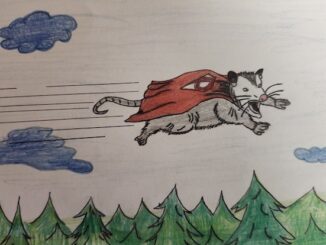
You’ve likely never heard of a company called Colossal Biosciences. I hadn’t until recently.
The bioengineering firm recently made headlines with its announcement that they have “de-extincted” dire wolves. They carefully scripted the story with large media outlets to drop at the right time, in the right way, to gain the most publicity for their company.
Amidst all the hoopla and misleading headlines, not to mention pictures of cute fluffy white wolf pups howling “for the first time in 25,000 years”, it turns out they just mixed some DNA from dire wolf fossils with gray wolves, created embryos that were inseminated into dogs, and declared them gray wolves. Perhaps three of 56 embryos survived to be born. Only two of those are still alive.
Dire wolves went extinct millennia ago; I am not going to argue with you about whether the earth was created in six days less than 10,000 years ago, or billions of years ago when a star burped. You are welcome to believe the science of man, if you will. I’ll stick with the word of the one who created man in the first place.
Anyway, Dire wolves were an apex predator in their time period. They weighed 150 to 250 pounds, and were faster, bigger and stronger than gray wolves. Their jaws were designed to crush large bones. They were contemporaries and competitors with saber toothed cats. Dire wolves apparently died out as the largest species of prey animals – mammoths and such – passed into the annals of history and fossil records. Whether they were hunted by man or died as a result of a mass extinction event is yet another hot topic of debate, and depends on whether you believe in the eternal evil of the human race or the religion of manmade climate change.
Like a lot of trappers, I immediately began calculating what size foothold would be needed to hold a 250-pound wolf that would want to eat me. I figure the trapper would have to market to the specialized fur trade, or maybe taxidermists, since the furbuyers on the national market would still likely grade even a six-foot-long wolf hide with a three-foot tail as low, and offer maybe $20 on the auction, winter prime.
While I am not one for wiping out humans in hopes of preserving a snail, I don’t like seeing any species extirpated. Animals fascinate me, both as an outdoorsman and a conservationist. I’m skeptical of anyone or anything that screams loudly about the world coming to an end if we do not protect the polar bears from nasty old humans, despite the fact that there are supposedly more polar bears now than there were a hundred years ago. From what I’ve seen, humans who don’t have enough sense to leave polar bears alone kind of deserve what they get.
I love to hunt and trap, but every true outdoorsman knows you don’t shoot all the birds in a covey of quail. Indeed, the proliferation of predators caused by man’s interference has made it so there are darn few quail to hunt, much less enough to shoot. I have a covey at my farm that has split into two flocks, and I zealously protect their ditchbanks and nesting areas, and try to keep the predator population under control and away from “my” birds. I sincerely doubt I’ll ever be able to see a pointer freeze and raise a paw at one of my coveys, but maybe somebody else will, someday, when the quail come back. I just want to do my part.
I’m rather serious about conservation and stewardship, but I’m also practical. If a four-lane highway is needed to improve travel and commerce, a subset of a species of mouse should not be allowed to put the brakes on the whole project. The owls, hawks, weasels, foxes and bobcats can find another brand of mouse for dinner.
There’s a balance, a delicate balance, between serving the needs of man, and of man serving the needs of the world, as God instructed Adam and Eve.
That means sometimes things die off, including dire wolves.
Aside from the obvious dishonesty of saying Romulus and Remus are dire wolves, as opposed to gray wolf hybrids, I’m concerned over just exactly what the heck these people intend to do when they start mass producing these “extinct” animals. Next on the list is a wooly mammoth, which some scientists have said will be a lot easier than we might realize, due to the perfectly frozen remains that turn up every once in a while in Russia, Canada and elsewhere. Plus they have already made wooly mice, of all things, to show it can be done.
Romulus and Remus will never be released into the wild; they’ll never be put on display. I guess they will just have to live a rather sad life in a controlled environment where they don’t get to hunt, but instead are fed and periodically poked and prodded. Makes me feel sorry for the things that could and likely would happily eat me as the weakest member of the herd if we ever met under different circumstances.
Shoot, I’ve dealt with 35-pound coyotes, 50-pound (DNA proven) coywolves and five-pound chihuahuas that wanted to drag me down and eat me. I’ll never forget the 50-plus pound coyote that tried to do just that years ago. And yes, the scales used to weigh said critter was a good set of scales, not the ones where people weigh the big fish they caught behind the post office.
I’ve sure a wolf as big or bigger than me would figure I might be a little tough and stringy, but when you’re hungry, that’s better than nothing.
I have a suggestion: let the Colossal people make their hybrids.
Don’t just stop with the wolves, though; recreate massive herds of mammoths. Bring back the six-foot long beaver. Breed saber-toothed cats. Maybe the hairy rhino, or one of those ostrichasauruses on steroids that stood ten and twelve feet tall.
Recreate their habitat in some remote place, properly fenced in, of course, and make it a Stone Age paradise.
Finance it by selling a few hunting permits per year, much like the permit hunts in Africa (those African hunting trips, by the way put more money back into conservation and protection than a combination of all the TV commercials for $19.95 credit card donations). Make the permits a million dollars per head, with no guarantee.
But with a twist: only primitive weapons may be used. Like, truly primitive weapons – stone-headed spears. Clubs. Bone knives. Atl-atls and stick bows. No professional guides with a high powered rifle to fix your mistakes. And no modern clothing or comforts, either. Bare feet, furs and maybe a loincloth.
I can almost promise you people would be lining up for the privilege.
Win or lose, the hunters would be financing the propagation of these extinct species. If their hunts were successful, they’d be all over magazine covers and the media. If they were not successful – well, they’d still be famous as being an idiot who paid a million bucks for the privilege of being eaten by an animal that’s been dead for millennia.
The earth changes; it has since it was formed. Animals evolve, they grow, they adapt, and they die off. We have coyotes twice the size of western coyotes because we have more deer than rabbits in the east. Skunks couldn’t survive canine distemper, but now they are coming back to Southeastern North Carolina with a vengeance. Armadillos are moving here because they have outgrown the original territory they invaded with the help of man. Beavers flourished when man quit trapping them as much, and altered the landscape in ways that made it better for them.
Some animals, however, died out for a reason.
As cool as it might be to see a herd of woodland buffalo arguing over territory with wooly mammoths, while being stalked by sabertoothed cats on side and wolves on the other, the days for those species are gone.
We need to do everything reasonably possible to prevent other species from going extinct, as a matter of principle. We need to learn about extinct species, respect them and teach about them.
But we don’t need them back, no matter how badly some scientists want to play God.























